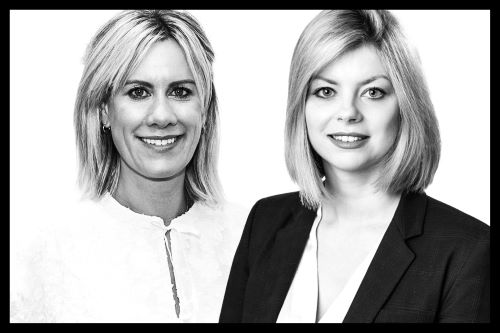Don’t be so humble
- Date: Mon, Jun 10, 2024
Share this article
By Beth Kocher Gormley, PR and Communications Manager

Pictured (l-r): Clair Daly and Marie Fitzgibbon, Executive MBA graduates from UCD Michael Smurfit Graduate Business School
In the dynamic world of innovative enterprises, the representation of women in senior leadership roles remains strikingly low.
Clair Daly and Marie Fitzgibbon, Executive MBA graduates from UCD Michael Smurfit Graduate Business School, have embarked on a compelling research project to explore the barriers to female leadership in innovative enterprises and hope to contribute to creating a more equitable environment for future female leaders. Their findings offer valuable insights and potential solutions to enhance gender diversity in leadership roles, a subject of growing importance in today's corporate landscape.
Both Daly and Fitzgibbon have personal and professional motivations driving their research. Daly is Head of People at Quintain Developments Ireland and Fitzgibbon is the EMEA Medical Advisor at Janssen (J&J).
Their experiences, observations, and ambitions have fuelled their interest in understanding why women are underrepresented in innovative leadership roles.
Daly and Fitzgibbon's research centres on the underrepresentation of women in senior leadership positions within innovative sectors, including technology, pharmaceuticals, telecommunications, e-commerce, banking, venture capital, start-ups and education.
The research involved interviews with high-profile leaders within these industries ranging from founders and CEOs to CROs, COOs, academics and board members who provided valuable insights into the barriers women face in climbing the corporate ladder.
“Despite women making significant strides in various industries, their presence in top executive roles, especially in innovation-driven fields, is disproportionately low,” said Daly, a native of Tralee, County Kerry. “Our aim was to identify and understand the specific challenges women face in ascending to these high-level positions.”
Their findings revealed two key factors.
- Contrasting Leadership Styles
Men and women tend to exhibit different leadership styles. Traditional masculine traits such as confidence and risk-taking are often associated with effective leadership in innovative projects. In contrast, feminine leadership qualities like warmth and consideration are not typically viewed as directive or authoritative.
- Humbleness as a Barrier
The most surprising finding was that humbleness, often linked to a lack of confidence, is perceived as a significant barrier for women.
Senior executives noted that this trait could hinder women's progression to leadership roles in innovation. While men might face similar barriers, they are less likely to openly portray such traits, which affects their career trajectories differently.
“We confirmed humbleness as the main barrier to female leadership in innovation, in addition to several known barriers such as gender bias, work-life conflicts and a lack of professional support,” commented Daly.
Surprising Results
“The revelation that humbleness is a significant barrier to female leadership was unexpected,” explained Fitzgibbon, who is originally from Oola, County Limerick. “This perception, tied to a lack of confidence, suggests that women might need to adopt more agentic, self-directed qualities to succeed in innovative environments. However, this is not about changing women's inherent qualities but rather about fostering an environment that values diverse leadership styles.”
Daly and Fitzgibbon hope that their research will increase self-awareness among aspiring female leaders and encourage companies to provide education, support and mentorship to close the leadership gap.
“By addressing these barriers, organisations can enhance gender diversity in senior roles, which has been shown to improve overall company performance,” continued Fitzgibbon.
“If both women and companies act on these insights, the research could lead to significant societal changes, potentially influencing public policy and industry standards.”
Throughout their research, Daly and Fitzgibbon encountered intriguing anecdotes and reflections. One notable observation was that men, theoretically, face similar barriers like humbleness and lack of confidence but are less likely to exhibit these traits openly. Women, on the other hand, tend to adopt more communal qualities and voice their concerns, which are not typically associated with the stereotypical image of a self-directed leader.
Academic and Professional Contributions
This research project was part of their MBA module, Leading the Innovative Enterprise, and under the guidance of Dr Jan Rosier they completed a project on perceived barriers to female leadership in the innovative enterprise.
Through a targeted literature review and interviews with global leaders, Daly and Fitzgibbon identified and validated the unique challenges faced by women in innovative enterprises.
With novel findings that shed new light on the challenges women faced, their work was published in People Management, a leading HR guide in Ireland and the UK. Read the full article here: Three ways to break down the barriers to female leadership in innovation (peoplemanagement.co.uk) The article has already gained traction, being cited and shared within the professional community.
Future Direction and Commitment
The underrepresentation of women in senior leadership roles within innovative enterprises is a multifaceted issue that requires concerted efforts from both individuals and organisations. By fostering an inclusive environment that values diverse leadership qualities, companies can not only enhance gender diversity but also improve their overall performance. These research insights provide a valuable roadmap for future leaders and organisations striving to break down the barriers to female leadership in innovation.
Daly and Fitzgibbon are committed to further investigating these challenges, exploring perspectives from graduates, middle managers and other stakeholders. Their aim is to deepen the understanding of how these unique barriers manifest in various environments and to develop strategies for overcoming them.
“Our passion for this project prompted us to make the findings public as these insights provoke more important questions,” concluded Daly. “We are committed to further investigating and understanding the manifestation of these challenges in related environments.”
“The article represents an excellent example of opportunities made possible through UCD Smurfit School as MBA students. We are eager to ensure that the work and findings are shared throughout the school, alumni and wider networks in order to have a positive impact in the world of business.”
For more information and to read their published article, visit People Management: https://www.peoplemanagement.co.uk/article/1835686/three-ways-break-down-barriers-female-leadership-innovation












